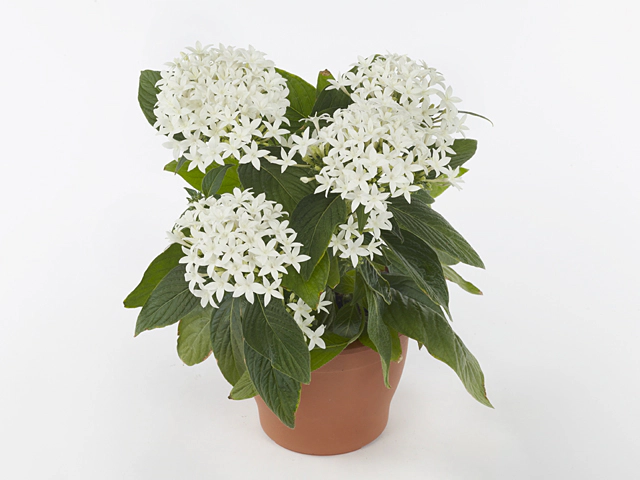Pentas lanceolata Lucky Star White

| Leaf arrangement | crosswise opposite |
| Winter hardness | Not hardy (USDA-zone 9,10,11) |
| Flower color | White-white-NN155D |
| Flower diameter | 1,5 - 2 cm |
| Plant height | 20 - 30 cm; 30 - 40 cm |
| Flower length/hight | 1,5 - 2 cm |
| Inflorescence | Corymb |
| Plantdiameter | 20 cm - 25 cm |
| Leaf width | 5 - 7,5 cm |
| Leaf size | 10 - 15 cm |
| Plant, growth type | Erect |
| Leaf, main color | Dark green |
| Flower color distribution | Unicolored |
The Pentas lanceolata Lucky Star White is a beautiful flowering plant with a unique set of characteristics. Its leaf arrangement is crosswise opposite, giving it an attractive symmetrical look. However, one important thing to note is that it is not hardy in winter, meaning it can only thrive in USDA zones 9, 10, and 11.
One of the standout features of this plant is its stunning white-white flower color, described as NN155D. The flowers have a small diameter of 1.5-2 centimeters, making them delicate and dainty. The plant itself can reach heights of 20-30 centimeters or 30-40 centimeters, depending on the specific variety. Additionally, the flower length matches the height, measuring 1.5-2 centimeters.
The Pentas lanceolata Lucky Star White produces inflorescences in a corymb arrangement, which means the flowers form a flat-topped cluster. This adds to the plant's overall aesthetic appeal. The plant has a medium-sized diameter, ranging from 20 to 25 centimeters, providing a compact and manageable growth structure.
The leaves of this Pentas variety have a width of 5-7.5 centimeters and a size of 10-15 centimeters. They have a dark green main color, which contrasts beautifully with the white flowers. The overall growth type of the plant is erect, meaning it grows upright and doesn't require additional support.
Lastly, the Pentas lanceolata Lucky Star White has a unicolored flower color distribution, which means the entire flower is the same color without any mottling or streaks.
Overall, the Pentas lanceolata Lucky Star White is a visually appealing plant with its unique leaf arrangement, delicate white flowers, and dark green foliage. It is important to consider its winter hardiness before planting it, as it requires a warmer climate to thrive. Whether planted as a standalone specimen or in a mixed garden, this plant is sure to add beauty and elegance to any landscape.
Market availability index by month:
| Jan. | Feb. | Mar. | Apr. | May | Jun. | Jul. | Aug. | Sep. | Oct. | Nov. | Dec. |
|---|---|---|---|---|---|---|---|---|---|---|---|
| - | - | - | 3 | 3 | 3 | 4 | 3 | - | - | - | - |